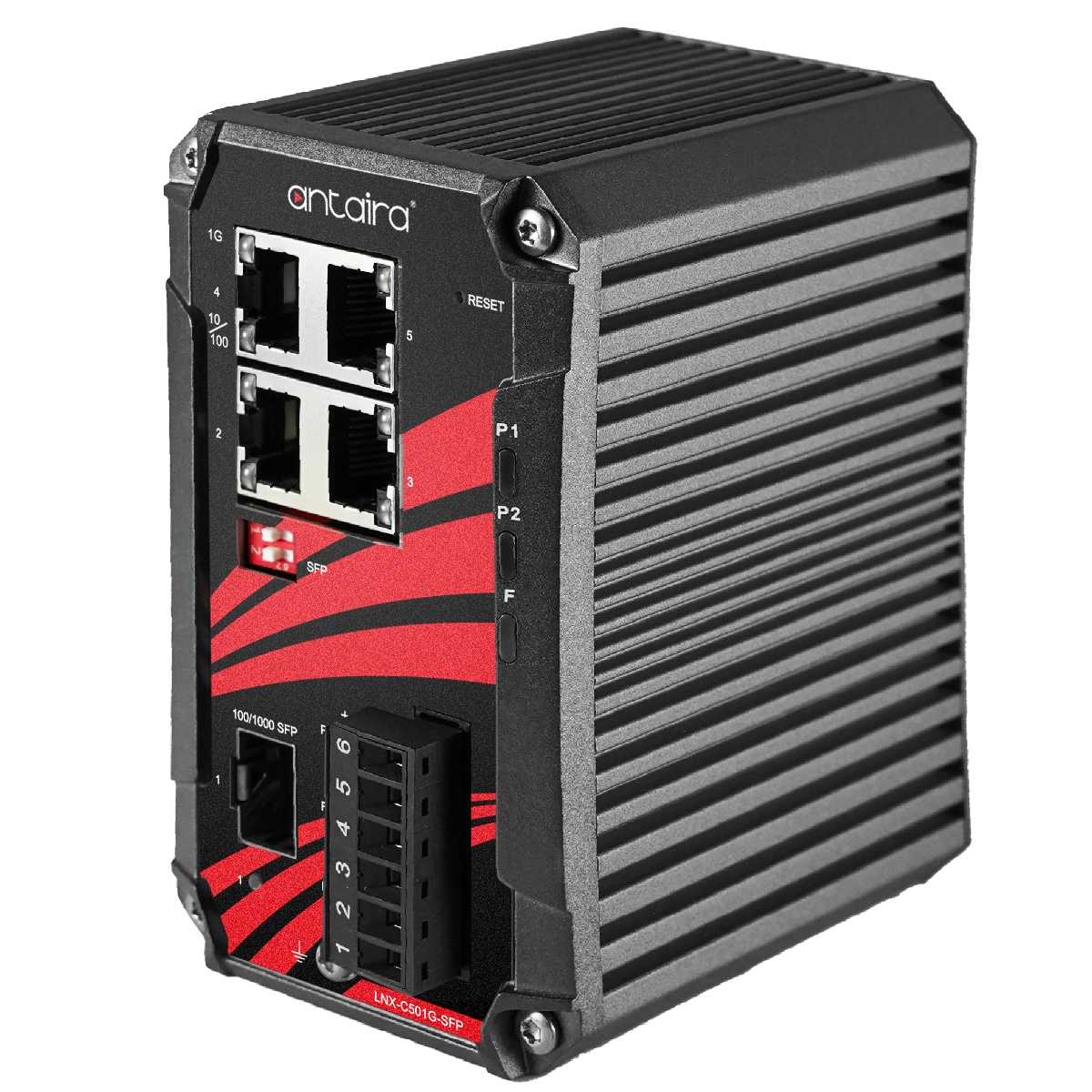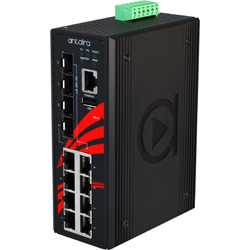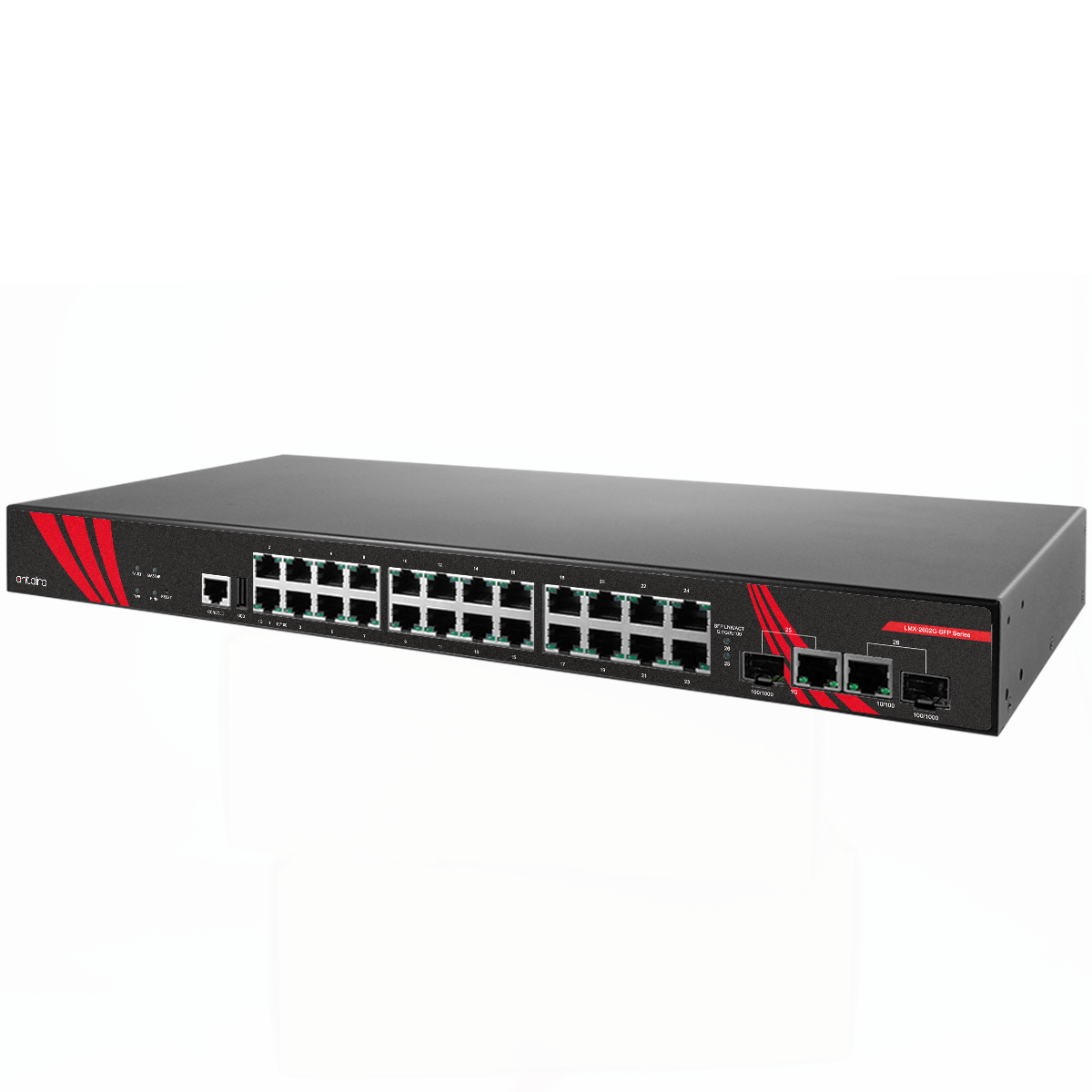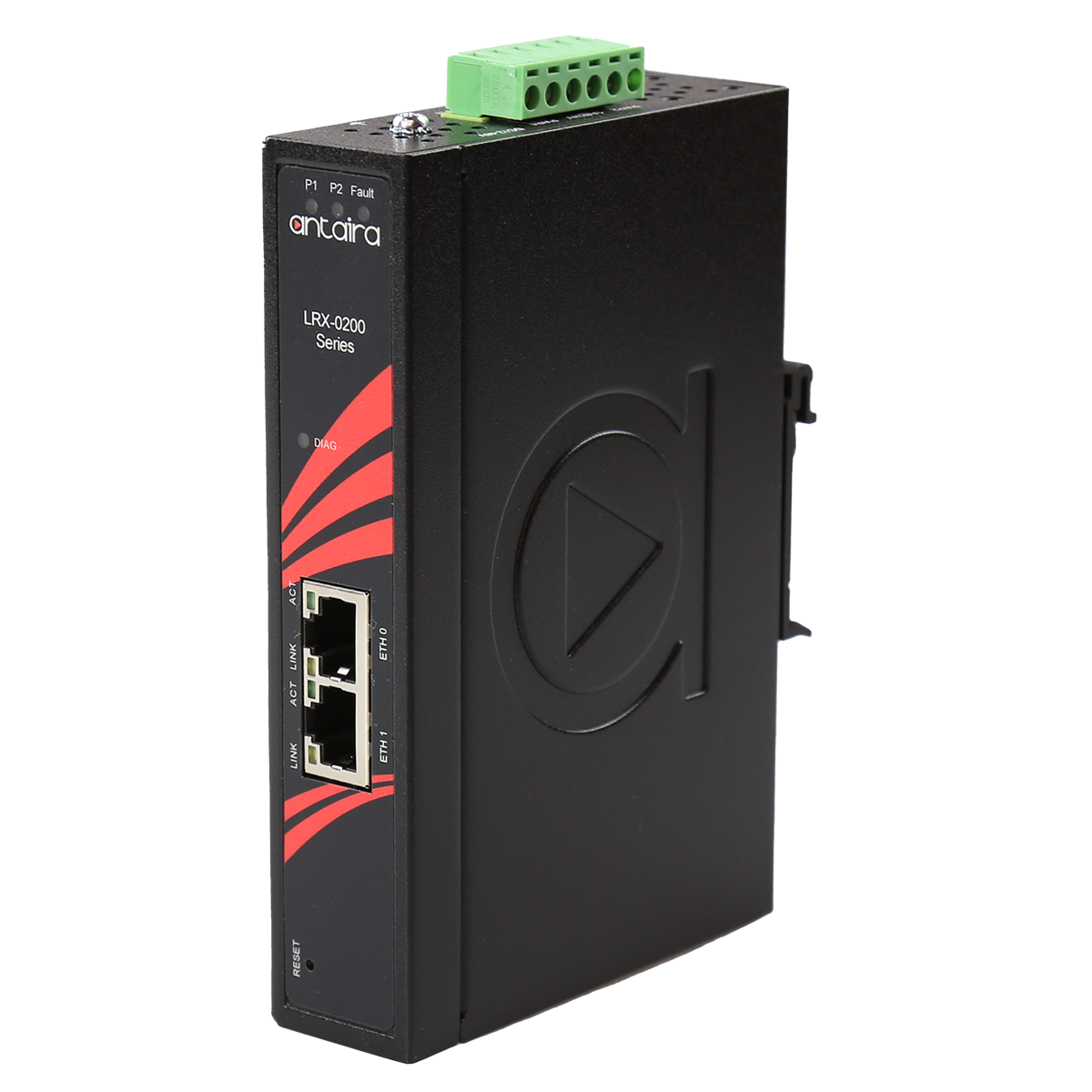Industrial Ethernet Switches
Antaira offers a variety of industrial Ethernet switches, including industrial-grade network switches, DIN mount switches, and Ethernet switchboards, that can perform efficiently in adverse weather conditions and industrial environments. Since 2005, we have designed and manufactured top-quality industrial switches with network redundancy that operate efficiently in rugged, mission-critical applications. Setup a reliable Ethernet infrastructure for all networks that features extended temperature tolerances and enclosures designed for the roughest environments. Various markets utilize our industrial Ethernet switches, including automation processes, smart transportation systems, security operations, and power/utility plants. Browse our industrial unmanaged switches, industrial managed switches, power over Ethernet PoE options, and din rail mountable industrial Ethernet switches below.
Our solutions allow for a seamless transmission and performance of data. We also offer M12 Ethernet switches which are ideal for applications with high shock and vibration, such as the rail industry. If you have any questions regarding our industrial Ethernet switches with various ports and fiber options for your industry application, please contact the team at Antaira Technologies to see our availability.
|
|
What is a Fiber Switch?
Fiber switches are networking devices that use fiber optic cables to connect devices on a network. They are used to connect devices such as servers, storage systems, and other networking equipment, and allow for high-speed data transmission over long distances.
Fiber switches use fiber optic cables to transmit data in the form of light, which allows for faster data transfer speeds than traditional copper cables. They also have a much larger transmission distance compared to copper cable, which allows for longer cable runs without the need for signal amplification.
Aren’t all Ethernet Switches the Same?
The short answer is, no, as there are commercial switches and industrial switches. Some people even question a switch vs router. However, Antaira decided early on, that we had some advantages in the industrial arena and would focus on quality first, then stand by it, by including a 5-year warranty that we offer on our industrial switches. We have our own manufacturing facility, so that we can quality control every product we produce from design through to successful installation. We even offer a 45-day, no question return policy. Why? Because we are confident that once you see, feel and install one of our Industrial Ethernet switches, you’ll understand the Antaira difference. To learn more about industrial Ethernet switch history and the future of switches, check out this article.
Network – Ethernet – Hardened – PoE Switches
What does it all mean? Many of the terms used, such as Industrial Network Switch, Industrie Ethernet Switch, and more are mostly interchangeable with small differences. However, other terms like Hardened Network Switch and PoE Ethernet Switches, although they look the same, they offer different and distinct features. Let’s explain some of the basics to an Antaira Industrial Switch.
Network or Ethernet Switches
To start, the switch is the device between a router and the intended device, or computer. So, it’s the routers job to connect networks, usually by connecting directly to multiple switches. Then the switches actually create the networks, by connecting to all of the devices (computers, printers, etc.) into a LAN (Local Area Network), where it forwards and receives data (packets) to and from the connected devices. For example, an office worker sending a print job to the nearby printer. This means that all of the computers, printers, etc. on a network can communicate with each other because the switch has connected them on a shared network.
What is a Hardened Ethernet Switch?
The word hardened, in our context, means strengthened. So, in the case of a Hardened Ethernet Switch, it means that it’s been strengthened, in particular to outside and extreme elements, such as dirt, dust, high-low temperatures, rain (moisture), snow and inclement weather.
For Ethernet switches that will be installed outside, in “noisy” environments (such as in a manufacturing facility or one with possible electronic interference) or corrosive environments, Antaira offers select models with a corrosion protection called Conformal Coating, and full metal casings (eg; prevents crushing to accidents, branches, being dropped, gaseous contaminates, etc.) to protect it and its components. Our Hardened Ethernet Switches also have a standard operating range of -10°C to 70°C and an extended operating range of -40°C to 75°C.
To understand how this type of corrosion could happen, let’s talk about how corrosion occurs. Corrosion is a chemical reaction that is primarily caused by an attack of gaseous contaminants, and then accelerated by heat and moisture. Such environments like waste water plants, mines, chemical and power plants are obvious ones, but simple areas where moisture and temperature swings occur are just as common. When equipment is installed outside in the ambient air, moisture and oxygen trigger corrosion on metal surfaces, such as those found in electronic equipment. Other environments, such as those that burn fossil fuels and chloride, like water treatment plants, emit gases like Sulfur Dioxide, which also accelerate the corrosion process.
Many standards, such as ISO (International Organization for Standardization), ANSI (American National Standards Institute) and the ISA (International Society of Automation), have all developed multiple standards to determine the level of corrosiveness, that exists in these types of environments. Antaira’s process for Conformal Coating meets or exceeds some of the highest classifications by these organizations, for corrosive environments.
For more information on the exact corrosion standards that Antaira’s process meets or exceeds, visit Antaira's Conformal Coating Solution page for more detailed information with our industrial switches.
WHAT IS A POWER OVER ETHERNET (PoE) SWITCH?
Most networking equipment that we’re all familiar with (eg. Servers, routers, switches, etc.) require both a power cable and network cable to operate and be “plugged into” the network. Not true for PoE equipment. PoE, or Power over Ethernet, means that the PoE device receives its power through the Ethernet cable (Cat5, Cat5e, Cat6, etc.) instead of requiring power adapters and cords that are plugged into an outlet. For more than 15 years, Antaira has built and sold our Industrial Hardened PoE Ethernet Switches, that only require a simple PoE network cable for both the network traffic, as well as providing the electricity to power the PoE devices. This means that there is reduction in cabling and in the risk of electrical shorting, as well as making the units more reliable and rugged, having a much faster deployment time and ensuring critical uptime.
As the number of devices companies use to connect their employees rises, so does the need for PoE devices. You may not know, but you may be already using PoE devices. Many VOIP phones, remote cable-connected security cameras and wireless Access Points are all PoE devices and commonly used in both commercial and industrial applications.
In your search for an industrial PoE switch, you’ll find three common types – PoE, PoE+ and PoE++. Antaira offers PoE switches that meet all industry standards: IEEE 802.3af (PoE), IEEE 802.3at (PoE+), and IEEE 802.3bt (PoE++). Also, within those types there are additional sub-types (eg. PoE++ has Type 3 and 4), so it’s critical to work with a trusted partner to determine which switch best suits your needs and the demands of your environment. PoE, PoE, and PoE++ differ in max port power, port voltage range, twisted pairs used, max power delivered to the device, and voltage range to the device.
One benefit of PoE switches is a reduction in costs. This is both in the simplicity of deployment (less cables, less time to install, etc.), and a reduction in cables and electrical outlets. Akin to cost, is adaptability or ease of deployment. Since the power is transmitted in the cable, installing a PoE switch outside on the side of a concrete building for example, would be easy, as compared to the cost and time in running power and an outlet to that same location (which requires a certified electrician). Power management is another benefit, where a PoE device can detect power consumption by other PoE devices on the network and can both take and allocate power to minimize the production and consumption of power, helping to save you money.
If you’re ready to shop our industrial PoE switches, here are a few helpful links:
What is the difference between managed and unmanaged switches?
As the name depicts, you can manage a managed switch. Unmanaged switches firmware provides the necessary instructions to allow them to self-configure and run on a local network. An unmanaged switch, simply put, adds more available ports to connect to the network, although it doesn’t show up as a device itself on the network. From the traditional functionality of the two, there isn’t much difference. However, if I offered you a 20-year-old Nokia and a new iPhone, which would you choose? After all, they both make calls perfectly, which is their sole purpose, right? We all know that they both make calls, but after that, they are completely different, with the iPhone able to be remotely upgrade with new functionality, apps, and much more, albeit at a higher price. It appears on the network as a device, which can be remotely managed, updated and can have new features added.
Both the unmanaged and managed switches receive and forward data packets to connected devices in the same way. Being able to manage the unit, means that you can remotely custom configure and optimize the switch. This results in normally two main benefits. The first is that a managed switch usually provides a significantly better overall network performance, which means more speed. The second is that it provides a much better layer of security. Since they actively monitor and control network events, if it detects a threat or unauthorized access, it can shut those down and encrypt communication quickly. An example would be the security cameras around a building. If they were all connected via unmanaged switches, the data would be forwarded from the cameras to its destination the same as managed switches. However, if a camera was cut (eg. someone breaking into the building), an unmanaged switch would just keep forwarding packets from the other cameras, while a managed switch could be configured to automatically notify someone of a breach of a connected device not responding anymore.
One significant benefit of our industrial managed switches is that we offer a USB upload and backup of your configuration to support your data. This means that instead of manually setting up every switch from scratch, you can save any configuration to a USB drive, then re-use that prebuilt configuration to upload that configuration to any new managed switch, automatically replicating your configuration and setting up the switch for you automatically. After initial deployment, you can then remotely monitor the networks, troubleshoot problems and deploy fixes, control network traffic utilizing network redundancy, adjust security and much more.
What are Ethernet Extenders? Do I need one?
We’ve all experienced the headaches of wifi and its in-ability to consistently provide stable connectivity. So why do we all use wireless then? Well, frankly, because of its simplicity and setup across many devices. We also know that when a computer is plugged into an Ethernet connection, we get better network speed and a superior and reliable connection. So why don’t we all use Ethernet then. Ethernet requires a physical connection to the network, and the one main limitation of Ethernet is that a “network run,” or maximum length a cable can run is only roughly 330 feet. Many buildings, as the cables leave a server room, traverse the ceiling, come down the wall and into your cubicle can easily crest 330 feet, so IT staffs look to a powered device that can “boost” the signal and relay it along, creating an extension of that limitation.
Antaira’s Ethernet range extenders enable the extension of Ethernet systems over an existing VDSL or Coax infrastructure to remote locations, that provides communication far beyond the standard Ethernet distance limitations. Fiber is highly costly, and fragile in caustic environments, requiring more shielding than an existing Coax cable. That’s where our Ethernet extenders really make sense, both in the ease of implementation, as well as from a cost savings perspective. Antaira’s Ethernet over Coax converter and VDSL2 Ethernet extender are packed with features and capabilities, including 1*10/100/1000 base-TX LAN support and simultaneous voice/data transmission. These devices are simple, plug n’ play devices that deploy quickly and just make sense.
To shop, click the link below:
Introducing our Industrial Rackmount Switches
Now that you’re up to speed on the differences between managed and unmanaged on our industrial switches, let’s talk about volume. In other words, those of you with many devices and the need to connect them. This is normally done with larger switches, that are required to be hard mounted in a rack. These racks or cabinets are an industry-standard 19 inches mounting width and are highly modular and configurable, as well as providing durability and additional security and protection. For the larger switch chassis, we manufacture them with rackmount capability for all standard 19-inch industrial rackmount cabinets and server racks. All our rackmount switches come with either 26 or 28 ports, so with just a few, can easily support a division, section, or production floor.
Industrial rackmount switches can be used for a wide range of applications, such as though that demand wide bandwidth, high-density Ethernet connectivity and long-distance communication. Because of the incredibly fast millisecond-level multicast traffic redundancy that they provide, such switches are ideal for transportation, surveillance, manufacturing, and critical city-infrastructure applications that may experience adverse weather or other environmental challenges.
Our industrial rackmount switches will enhance automation systems, where we provide switches with all configurations, in either 26 or 28-ports, managed or unmanaged, 10/100/1000TX ports, Gigabit combo ports, RJ45 and SFP slots, and finally externally powered or PoE and PoE+ options. No matter what your needs are in rack mounted industrial switches, we offer many configurations to match your needs and budget. Take a look below to find yours today.
To shop, click the link below to see our solutions with various ports:
DO INDUSTRIAL AND RUGGED SWITCHES NEED A POWER SUPPLY?
Industrial switches, like other networking equipment, typically require a power supply to operate. The power supply is used to provide the necessary voltage and current to the switch's electronics, allowing it to function properly.
Industrial switches are designed to operate in extreme temperatures, high vibration, and exposure to dust and moisture. As such, industrial switches typically have a wide operating temperature range and are built to withstand these conditions.
The power supply used for industrial switches are also ruggedized and typically used in a wider voltage range, such as 90-264V AC or 18-36V DC. They also have surge protection and EMI filters built-in.
In some cases, industrial switches may also have a redundant power supply option, which can provide a backup power source in case of primary power failure, increasing the availability and reliability of the switch.
To shop power supplies and see our availability, click the link below:
WHAT IS REDUNDANT POWER ON A SWITCH?
Redundant power on a switch refers to the ability of the switch to continue operating normally if one of its power supplies fails. It is a feature that provides a backup power source for the switch, ensuring that the network remains operational even in the event of a power failure.
A switch with redundant power typically has multiple power supplies, one of which acts as the primary power source, while the others act as backups. If the primary power supply fails or experiences an issue, the redundant power supply automatically takes over to ensure that the switch continues to receive power.




